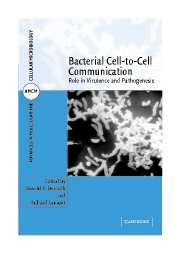Book contents
- Frontmatter
- Contents
- List of Contributors
- Preface
- 1 Quorum sensing and regulation of Pseudomonas aeruginosa infections
- 2 The Pseudomonas aeruginosa quinolone signal
- 3 Quorum-sensing-mediated regulation of plant–bacteria interactions and Agrobacterium tumefaciens virulence
- 4 Jamming bacterial communications: new strategies to combat bacterial infections and the development of biofilms
- 5 Quorum-sensing-mediated regulation of biofilm growth and virulence of Vibrio cholerae
- 6 LuxS in cellular metabolism and cell-to-cell signaling
- 7 LuxS-dependent regulation of Escherichia coli virulence
- 8 Quorum sensing and cell-to-cell communication in the dental biofilm
- 9 Quorum-sensing-dependent regulation of staphylococcal virulence and biofilm development
- 10 Cell-density-dependent regulation of streptococcal competence
- 11 Signaling by a cell-surface-associated signal during fruiting-body morphogenesis in Myxococcus xanthus
- Index
- Plate Section
- References
5 - Quorum-sensing-mediated regulation of biofilm growth and virulence of Vibrio cholerae
Published online by Cambridge University Press: 08 August 2009
- Frontmatter
- Contents
- List of Contributors
- Preface
- 1 Quorum sensing and regulation of Pseudomonas aeruginosa infections
- 2 The Pseudomonas aeruginosa quinolone signal
- 3 Quorum-sensing-mediated regulation of plant–bacteria interactions and Agrobacterium tumefaciens virulence
- 4 Jamming bacterial communications: new strategies to combat bacterial infections and the development of biofilms
- 5 Quorum-sensing-mediated regulation of biofilm growth and virulence of Vibrio cholerae
- 6 LuxS in cellular metabolism and cell-to-cell signaling
- 7 LuxS-dependent regulation of Escherichia coli virulence
- 8 Quorum sensing and cell-to-cell communication in the dental biofilm
- 9 Quorum-sensing-dependent regulation of staphylococcal virulence and biofilm development
- 10 Cell-density-dependent regulation of streptococcal competence
- 11 Signaling by a cell-surface-associated signal during fruiting-body morphogenesis in Myxococcus xanthus
- Index
- Plate Section
- References
Summary
INTRODUCTION
Many species of bacterium exchange chemical signals to help them monitor their population densities, a phenomenon referred to as quorum sensing. Quorum sensing was first described over two decades ago in two luminescent marine bacterial species, Vibrio fischeri and V. harveyi (40), which have served as model species for studies of cell-density-dependent gene expression. In both species, the enzymes responsible for light production are encoded by the luciferase structural operon luxCDABE (13, 39) and light emission occurs only at high cell density in response to the accumulation of secreted autoinducer signaling molecules (40). In the 1980s, Eberhard et al. (11) purified the first homoserine lactone autoinducer from V. fischeri and showed that it was indeed a specific inducer of luminescence. In 1983, the basic features of the autoinduction system were revealed at the molecular level when the lux genes of V. fischeri were successfully cloned and expressed in Escherichia coli (12).
Although quorum sensing regulation has been analyzed in great detail in V. harveyi and V. fischeri, the study of quorum sensing phenotypes in the clinically important Vibrio species V. cholerae was virtually non-existent until quite recently. This was partly because, unlike V. fischeri and V. harveyi, V. cholerae does not possess luciferase genes and it was therefore unclear whether it possessed any genes that were regulated by quorum sensing. However, when the V. cholerae genome sequence was completed (22) it was revealed that V. cholerae contains several quorum-sensing genes similar to those of V. harveyi.
- Type
- Chapter
- Information
- Bacterial Cell-to-Cell CommunicationRole in Virulence and Pathogenesis, pp. 101 - 116Publisher: Cambridge University PressPrint publication year: 2006

